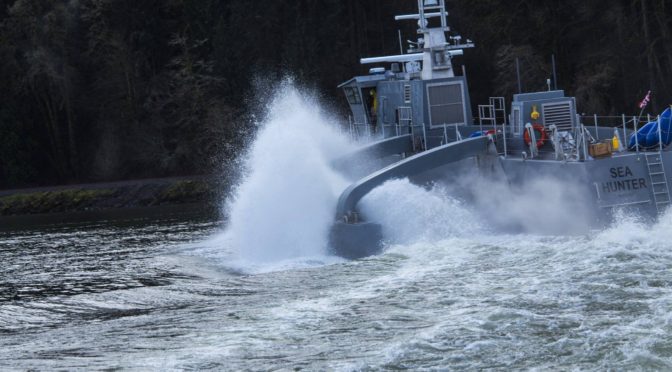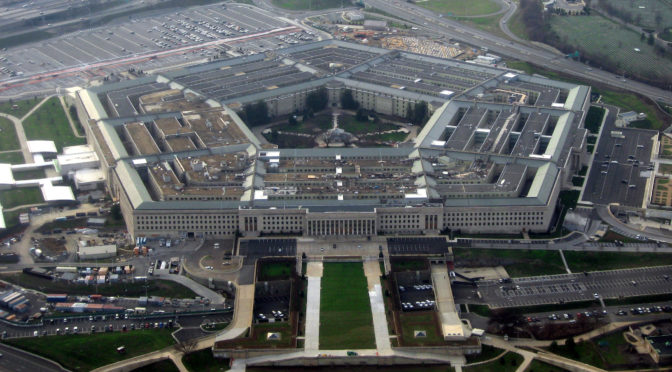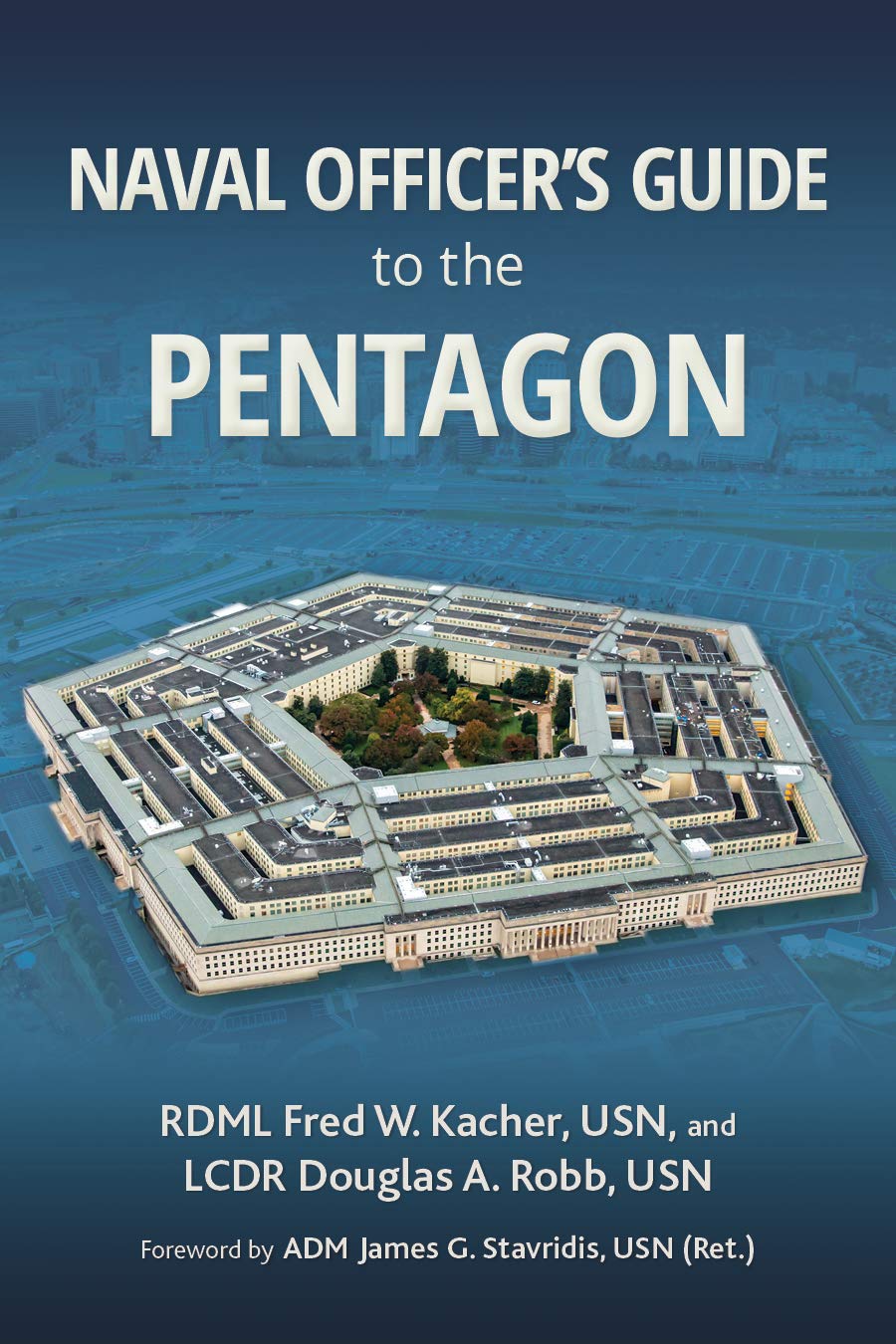By Norman Polmar and Scott C. Truver
“How often can you be at the christening of a robot warship?” Deputy Secretary of Defense Robert Work asked the crowd at the baptism of the Navy’s Sea Hunter unmanned surface warship in 2016.1 “…You’re going to look back at this day just like… when the USS Nautilus was christened, or when the USS Enterprise was commissioned,” he said. “And you are going to look back on this and say, ‘I was part of history.'”
Also part of that history, President Trump and the Navy Department are in tenuous agreement that the U.S. Navy requires 355 manned and unmanned ships, a significant increase from the current force of some 290 ships. This requirement is in part based on great power competition with China and Russia, which involves a growing renaissance in naval and maritime activities. Further, the world situation continues to witness crises, terrorism, and civil wars raging across Africa, the Middle East, and Asia. Yet even in “peacetime” naval ships are invaluable to represent U.S. political and economic interests in many areas of the world. Considering this global political-military environment, innovative concepts are essential to sustaining U.S. sea power.
A family of large, medium, and small USVs will take advantage of new technologies – some only dimly perceived in early 2020 – to provide increased capabilities to the Fleet with reduced construction, maintenance, and manpower. Getting there from today’s fiscal environment is critically important, and there is still much work to do to increase trust and develop CONOPs, but the potential for these unmanned vehicles to transform the future Navy is astounding.
“But I got to tell you,” Vice Adm. Richard Brown, commander of Naval Surface Forces and Naval Surface Force Pacific, warned the Surface Navy Association, “the security environment isn’t getting any more secure, it’s getting less secure, and it’s a maritime security environment hands down. And when the United States Navy’s not there, it creates a sucking vacuum and people fill it in. And it’s usually not good people.”2
Significantly, in December 2019, during deliberations on the president’s budget, the Navy proposed a 287-ship force by fiscal year 2025. “But that level,” Bloomberg News explained, “which includes the decommissioning of 12 warships to save money, would be well below the long-term 308-ship target set by the Obama administration and even farther from President Trump’s goal of 355 ships.”3
The Office of Management and Budget (OMB) has directed the Navy and the Department of Defense to review force level goals, and reiterated the need for a “resource-informed plan to achieve a 355-ship combined fleet, including manned and unmanned ships, by 2030.” Acting Navy Secretary Thomas Modly issued a 6 December 2019 memo to his staff that was “in sync” with the White House/OMB directive. He called for a plan to achieve a fleet of 355 or more ships “for greater global naval power within ten years” that includes robust levels of unmanned systems.4
U.S. shipyards could deliver the additional ships, even taking into account the accelerated retirement of outdated ships, but it would not be easy. Several yards are short of skilled workers, contributing to increasing ship construction and maintenance times. There are other constraints listed by Bloomberg: “Looming over the push to accelerate shipbuilding is an inconvenient truth outlined on December 4 by the Government Accountability Office: “The Navy continues to face persistent and substantial maintenance delays that hinder its ability to stay ready for operations and training. Since fiscal year 2014, Navy ships have spent over 33,700 more days in maintenance than expected.’”5
Another problem with a larger fleet is the requirement for even more personnel: The Navy currently is short some 7,000 sailors. More ships will demand more sailors, a problem in the current, highly favorable U.S. economy.
“I think the number we identified matches the ownership costs that we identified,” said Rear Adm. Brian Luther, deputy assistant secretary of the Navy for budget, during congressional testimony.6 “So we grow in lead of some of the equipment because we have to train people ahead of when the ship arrives. It was a disciplined approach to ensure we didn’t procure a ship without people, [and] we didn’t procure a ship without armament. So, it’s a very balanced and disciplined approach.”7
A practical and near-term Surface Force solution is unmanned surface vessels (USVs). Successful testing of the DARPA and Office of Naval Research prototype Sea Hunter underscores the feasibility of USVs. During her evaluation, the 132-foot-long trimaran Sea Hunter sailed—unmanned—from San Diego to Pearl Harbor, and back, and conducted a variety of demonstrations, showcasing the ability to host a variety of mission payloads. While important lessons were learned, there were no significant problems during her 5,000-mile voyage.8 The Sea Hunter has since transitioned to the Navy’s Surface Development Squadron ONE (SURFDEVRON-1), and the Navy is testing two other USVs as part of the Pentagon-sponsored Ghost Fleet program.9
“Because it is big and it has a lot of payload capacity, and because it also has a lot of range and endurance, it can potentially carry out a range of different missions,” Scott Littlefield, former DARPA program manager in the tactical technology office, predicted in 2016.10
Follow-on USVs are now being developed and procured by the Naval Sea Systems Command to provide increased capabilities at reduced costs. The Navy is shaping multiple competitions for successors—a “family” of small, medium, and large USVs—that look to operationalize how a more advanced USV could be employed for a broad spectrum of missions and tasks. In December, the U.S. Fleet Forces Command (FFC) issued a notice asking the service’s surface force to develop a concept of operations (CONOPS) for the large and medium USVs in development.11
“The MUSV will initially focus on intelligence, surveillance and reconnaissance (ISR) payloads and electronic warfare (EW) systems, while the LUSV will focus on surface warfare (SUW) and strike missions,” the FFC explained. “The fundamental capabilities of these platforms may necessitate changes in how Carrier Strike Groups, Expeditionary Strike Groups and Surface Action Groups conduct operations. The CONOPS will describe the capabilities at initial operating capability (IOC), the organization, manning, training, equipping, sustaining, and the introduction and operational integration of the Medium Unmanned Surface Vehicle and Large Unmanned Surface Vessel with individual afloat units as well as with Carrier Strike Groups, Expeditionary Strike Groups, and Surface Action Groups.”
“Knowing what’s going on out there is extremely important,” Admiral James Foggo, the commander of U.S. Naval Forces Europe and Africa and NATO’s Allied Joint Force Command Naples, remarked in December. “So, for unmanned systems, [intelligence, surveillance and reconnaissance] is probably one of our limitations and we could use more of it. Indications and warnings are important. If you could put an unmanned system up, then there’s less of a risk, less of a threat.”12
Speaking at the U.S. Naval Institute’s defense forum in December 2019, the new Chief of Naval Operations Admiral Michael Gilday said that unmanned systems will be part of the Navy’s Integrated Force Structure Assessment expected in early 2020. “I know the future force has to include a mix of unmanned systems. We can’t wrap $2 billion platforms around missiles.”13
There has been programmatic success that looks to invigorate the USV family. According to Defense News, the Navy will get two large unmanned surface vessels (LUSVs) in 2020.14 The 2020 Defense appropriations bill funds the two LUSVs that the Navy requested, but prohibits funding for integrating/testing of vertical launch systems on those vessels, which is the heart of the LUSV mission. Congress also directed the service to prepare a comprehensive unmanned surface vessel plan before it charges ahead.
In that context, the White House and OMB told the Navy to develop a proposal for counting at least some of its unmanned surface vessels and underwater vehicles among its “Battle Force,” the portion of its fleet that has historically included larger, manned warships, such as aircraft carriers and destroyers, and support ships, according to The Drive.15 “This would be a major shift that would create a more realistic path for the service to meeting the ambitious congressionally mandated goal of a 355-ship Battle Force fleet and would help solidify the already growing importance of unmanned platforms in its future concepts of operation.”
The U.S. Navy is on the threshold of a new era in maritime-naval operations. “I think it’s well within the possibility that we’ll fight fleet on fleet with unmanned surface vessels deep into that fight,” Vice Adm. Brown predicted, “calling it a fundamental change to how the fleet fights akin to the introduction of carrier-based aviation to a battleship-centric fleet ahead of World War II.”
“[I]n in the United States Air Force, there are airplanes and drones,” Deputy Defense Secretary Bob Work remarked. “The Navy cannot make that mistake. There have to be warships. And it doesn’t matter whether they are manned or unmanned. They will take the fight to the enemy.”
Norman Polmar is a naval analyst, historian, and author. He is a consultant to Leidos on naval and maritime issues.
Dr. Scott Truver is a Washington-based naval analyst.
References
1. Bob Work, Deputy Secretary of Defense Speech, Remarks at the ACTUV “Seahunter” Christening Ceremony, April 7, 2016, Portland, OR, 779197.
2. Meghan Eckstein, “VADM Brown: Future Fleet Must be Bigger, Leverage Unmanned Vessel Vessels, USNI News, 13 January 2020.
3. Tony Capaccio, “White House Presses Navy to Stick with Trump’s 355-Ship Target,” Bloomberg News, 20 December 2019.
4. David B. Lartner, “US Navy to add 46 Ships in five years, but 355 ships won’t come for a long time,” Navy Times, 12 February 2018.
5. Ibid. See also, David Sharp and Lolita Baldor, “Navy Considers Shipbuilding Cuts for Upcoming Budget,” Associated Press, 28 December 2019.
6. Lartner, “US Navy to add 46 Ships in five years, but 355 ships won’t come for a long time,” Navy Times, 12 February 2018.
7. Eckstein, “Sea Hunter Unmanned Ship Continues Autonomy Testing as NAVSEA Moves Forward with Draft RFP,” USNI News, 29 April 2019.
8. Ibid.
9. “US Navy starts second phase of Ghost Fleet Overlord Programmed,” Naval Technology, 3 October 2019.
10. Adam Stone, ‘ACTUV on Track for Navy Success Story,” C4ISRNET, 21 December 2016.
11. Nathan Gain, “US Navy Issues Request for LUSV/MUSV CONOPS Development,” Naval News, 6 January 2020.
12. Epstein, “Foggo: Navy Needs Unmanned ISR, Tankers to Counter Russia,” USNI News, 18 December 2019.
13. Matthew Cox, “The new acting Navy secretary wants a fleet larger than the current 355-hull plan,” Military.com, 10 December 2019.
14. Lartner, “The U.S. Navy Gets Its Large Unmanned Surface Vessels In 2020 With Strings Attached,” Defense News, 21 December 2019.
15. Joseph Trevithick “White House Asks Navy To Include New Unmanned Vessels In Its Ambitious 355 Ship Fleet Plan,” The Drive, 20 December 2019.
Featured Image: The unmanned Sea Hunter vessel during testing. (Still image from DARPA video)




